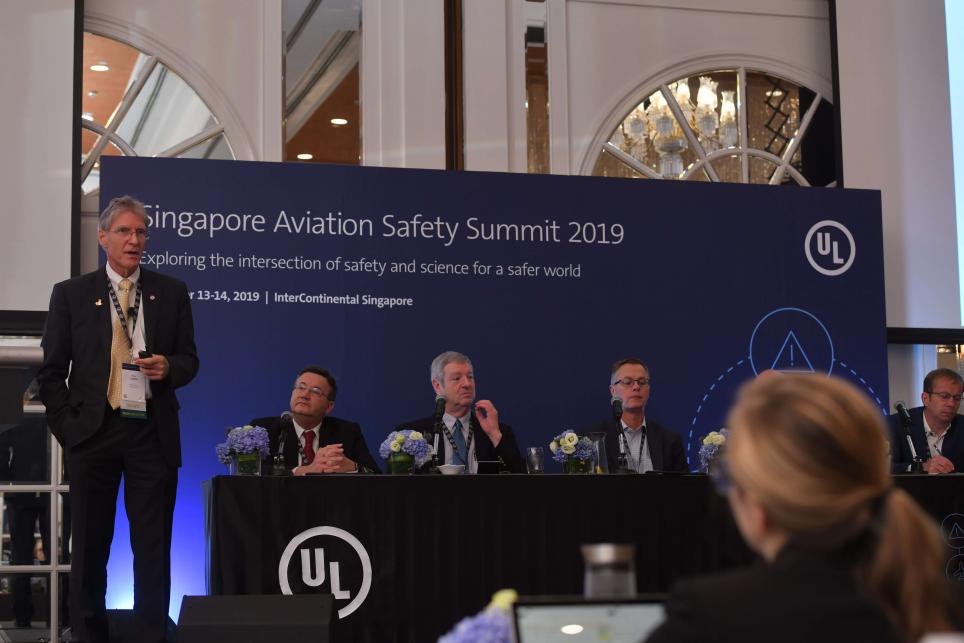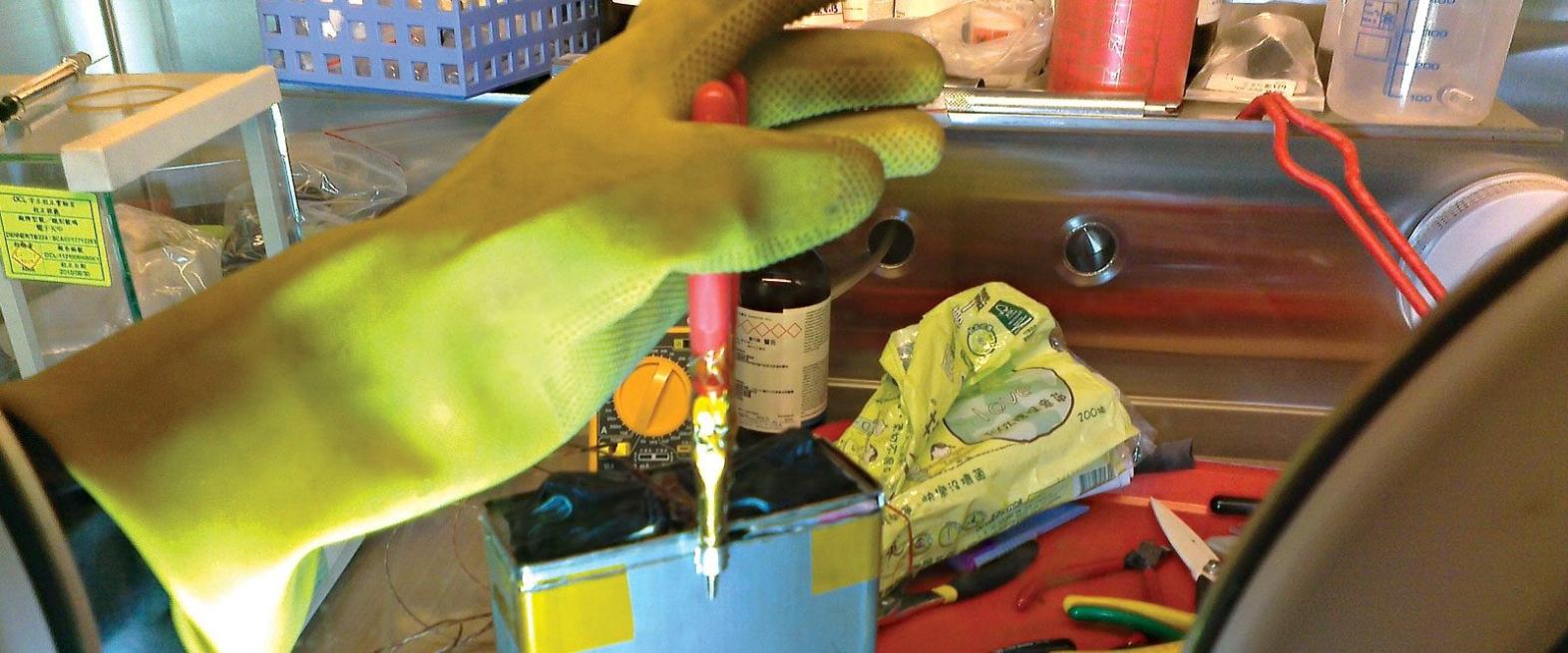Air transport disasters among leading safety risks presented by Li-ion batteries
The exponential rise in the use of small electronics, handheld devices, small medical devices, wearables and more has led to the widespread use of lithium-ion batteries, many of which aren’t thoroughly vetted for safety. Air transport disasters are among the leading safety risks presented by these small, lightweight batteries, which hold significant amounts of energy relative to their size.
As a widely recognized expert resource for fire and battery safety science, UL Research Institutes helps ensure that safety practices keep pace with innovation. Greater battery power means greater risks to aviation safety, and UL research has shown how lithium-ion battery failure — even in a single cell — can lead to thermal runaway, with potential catastrophic effects. As an independent, trusted, non-commercial advisor that leverages the expertise and change-making power of action-oriented science and industry leaders, we are collaborating broadly to help address this critical issue in portable energy storage and transportation.
We are employing a multipronged approach to address high-priority issues in aviation battery safety by leveraging core capabilities and recognized technical expertise in conjunction with existing Safety Management Systems (SMS):
- State-of-the-art safety research: We survey the battery ecosystem to predict and understand new safety challenges for batteries in all applications.
- Lithium-ion battery research: We conduct applied research to determine boundaries of safety and identify optimum risk mitigation.
- Code and standards development: We interface with regulatory bodies, government, and industry to share data, research insights, and ultimately affect standards and regulations to elevate the safety of battery transportation via air.
- Advocacy: We act as a technical advisor for non-commercial aviation battery safety efforts, with a focus on battery cargo safety and related supply chain.
- Training: We train manufacturers and installers, as well as first responders and firefighters, on best practices regarding the safe manufacturing and instillation of lithium-ion batteries, as well as containment and suppression of lithium-ion battery fires.
The growing threat of battery-related aviation disasters
In the wake of several battery fire-related air cargo disasters, aviation stakeholders have expressed particular interest in advancing lithium-ion battery transportation safety standards for cargo shippers in cargo-only and passenger planes. However, the industry is still working on prototypes that would provide confirmation of safety, and UL Research Institutes has been a part of this effort from its inception.
Li-ion batteries hold a significant amount of stored energy and pose a serious risk of thermal runaway which can lead to a catastrophe if they are not manufactured, designed, or used correctly. In single cell shipments, during thermal runaway, the high heat of the failing cell can spread, making the adjoining cells thermally unstable (learn more about what causes thermal runaway). An entire battery shipment can be destroyed within a few seconds or burn for hours as the cells are consumed.
Pursuing new global safety standards
Dr. Judith Jeevarajan is vice president and executive director of the Electrochemical Safety Research Institute at UL Research Institutes. She has more than two decades of experience as a battery safety specialist. She also participated in the Boeing air disaster investigations in her previous role with NASA and worked on the battery redesigns that emerged from these incidents. Dr. Jeevarajan supported the Federal Aviation Administration (FAA) in understanding the failures and presented at the public hearing organized by the National Transportation Safety Board (NTSB).
Dr. Jeevarajan sits in a number of committees that work on developing safety standards for batteries during transportation for the aviation sector. This includes the Radio Technical Commission for Aeronautics (RTCA), which sets the standards for the FAA, and International Civil Aviation Organization (ICAO) which sets battery transport safety standards for the UN, with a special focus on lithium-ion batteries. Through ICAO and the Society of Aerospace Engineers (SAE), she is helping the UN shape regulations for the safe shipping of Li-ion batteries. This is a major part of how UL Research Institutes is influencing global battery safety from the standpoint of policy and standards.
Dr. Jeevarajan also serves as a member of the UN Informal Working Group (UNIWG) that is working on the recategorization of the hazards associated with lithium-based cells and batteries, in response to rapidly changing technology. Li-ion batteries are currently classified according to the mass/weight of lithium, but the team is moving to recategorize them based on the results of worst-case hazards created under off-normal conditions. Among other things, the committee is crafting all new packaging standards.
“(We) remain committed to this research and to producing highly valuable firsthand safety knowledge that industry and policy stakeholders will need in order to improve battery safety in the air.” — Dr. Judith Jeevarajan, vice president and executive director, Electrochemical Safety Research Institute
Making UL Research Institutes an indispensable safety partner
Dr. Tom Chapin is an experienced material scientist and former vice president of research for UL Research Institutes. He was involved with aviation safety research and dedicated to improving battery safety for aviation, from supply chain to battery chemistry and beyond.
In 2013, the NTSB launched an investigation into an incident in Japan and another in Boston in which a battery fire downed Boeing 787 Dreamliners. These two battery-related air disasters occurred within 10 days of one another. UL Research Institutes was summoned for its expertise in battery safety, and Dr. Chapin led a 22-person team across three countries that looked at aircraft charging systems and studied batteries on a cellular level.
They worked to answer two key questions:
- Why did the batteries fail?
- Why did aircraft certification miss the probability of these events?
This sparked UL Research Institutes' interest in solving this problem. From 2014 to 2017, Dr. Chapin embarked on architecting and executing five global summits focused on battery safety in aviation, mobility, and other devices. In 2017, this work came to focus exclusively on battery safety in aviation.
“Over (our) history, we’ve worked for the safety of the general public. Today, we are bringing over a century of resources and expertise to aviation. Pilots now recognize the value of UL and the head of the FAA’s Office of Hazardous Materials Safety called us ‘an indispensable partner.’ This recognition is an honor.” — Dr. Tom Chapin, former vice president, research, UL Research Institutes
Conclusions
The threat of battery-related air disaster is a global risk due to the rising use of lithium-ion batteries in different applications and devices. Without improving practices, standardization, and policies at every step — from manufacturing to transportation to usage — the risks will continue to increase. Stakeholders worldwide agree that it’s not a matter of if, but rather when.
In light of this, UL Research Institutes is dedicated to applying its expertise in battery safety science, standards development, and outreach to develop a new global framework that will advance the safe transport of lithium-ion batteries and minimize the risk of air disasters.
Fast Facts
Research from the Electrochemical Safety Research Institute has shown how lithium-ion battery failure — even in a single cell — can lead to thermal runaway, with potential catastrophic effects.
UL Research Institutes is part of a consortium of stakeholders dedicated to advancing aviation battery safety.
Efforts to advance safety include scientific research, standards writing, policymaking, data sharing, and more.
Our goal is to establish a new global framework for advancing the safe transport of lithium-ion batteries to minimize the risk of aviation disasters.

Underwriters Laboratories Safety Summit Examines Dangerous Cargo and Hazardous Materials in Aviation
Convening key stakeholders from a diverse cross-section of communities, the summit addressed the challenges facing passenger and cargo airlines when transporting dangerous goods, hazardous materials, and lithium-ion batteries.

Understanding the Aviation Industry's Perception of Battery Safety Risks
Underwriters Laboratories commissioned a study of 400 North American aviation and aerospace industry professionals to assess industry views of passenger aviation safety risks, particularly those related to lithium-ion batteries. The results revealed several key findings.
